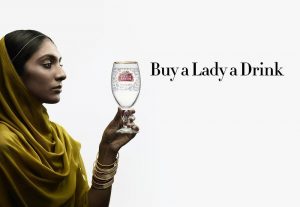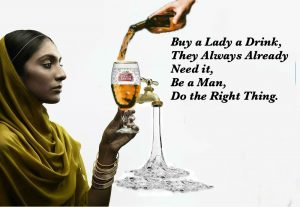Welcome to UBC Blogs. This is your first post. Edit or delete it, then start blogging!
Category Archives: Uncategorized
Buy A Lady a Drink: Jammed and Busted
Introduction:
Stella Artois has partnered with water.org to raise awareness for the water crisis and support the campaign for clean drinking water to disadvantaged communities, specifically to benefit the women of such communities. I do think that water.org is doing some good for the world with their initiative, but the partnership with Stella and this ad campaigns existence, rhetoric, images and text pose issues that need to be addressed and jammed. 
The original ad here depicts a woman of color holding a Stella Artois Chalice; in total I have found 4 different ads that represent the Buy a Lady a Drink campaign, all of which employ women of color. Here there are 3 main problems that I will attempt to ‘bust’ in the ad, Consumer Capitalism, Androcentrism and Global Inequalities.
Analysis:

The over arching theme of the ad is the clear representation of Stella framing beer consumption as ethical. The cultural capitalism employed here illustrates the neoliberal arena this ad and others like it occupy. In that it individualizes the social responsibility to help others, and binds this help with consumption. Resulting from the individual purchases, social supports are to be provided to those individuals in need, yielding moral acclaim for the consumer. A sort of trade triangle enclosed with in and fueled by the capitalist system.
Here the slogan ‘Buy a Lady a Drink’ is direct and implicitly targeted at men. This text speaks to the patriarchal rhetoric in our culture that men are to be leaders economically and socially. Where women are framed as dependent on the economic and social dominance of men. The slogan reflects the common urge and circumstance in bars, where men, in attempt to court women, purchase drinks and initiate interactions, showing both economic and social prowess. Here this common happenstance is inlaid on a global scale as it implicating the intersections of the woman and her ‘race’.
Stella Artois is a European beer that is generally, although not exclusively, marketed towards upper class white males in the western world. Beer in general represents a luxury good, in that in no way is it necessary for life. This is juxtaposed with the campaign claims to provide, clean drinking water (for women). Here we have clear representation of Western Charity and the divested 3rd world, in particular women of the 3rd worlds deprivation.
The ad normalizes existing local, western, inequalities between the sexes and superimposes inequalities of global proportions. Not only are they normalized but promoted! For it is the local disparity that initiates the feeling the ad is trying to employ to sell the product.
Explanation
In my Jamming of the ad I choose to address the images, and the text. The changes to the images were to show the absurdity of the neoliberal rhetoric, which here implies essentially turning beer into water. Here the tap faces the same direction as where the beer is coming from to show again who is in control of the water supply. The white hand filling up the glass from above and out of scene represents the omnipresent white male savior. It illustrates also the neoliberal model, capitalism supplying both the luxury beverage of beer and the life essential water. The water here is shown spilling out of the tap to illustrate that the attention and focus is not on water, but on the moral feel good that is transferred to the consumer.
The text already resonates with a common rhetoric discussed above of a man buying a drink for women. I Chose to explicitly state ‘Be a Man, Do the Right Thing’ to show explicitly the androcentric connotation. Playing on the cultural conditioning that states men should take care of women and women need men to take care of by men.
The lines ‘They always Already Need it’, are there to communicate the idea that women, and women of color especially, are framed and regarded as always already victims and in need of assistance. This rhetoric is only implicitly interpreted by the reader of the original line ‘Buy a Lady a Drink’, it does so by insinuating that by buying Stella, the feeling is as if he had just bought a woman a drink in a bar, assuming both that this is right, needed and just, hence ‘Be a Man, Do the Right Thing’. This purchased moral high ground is doubled as the women here is framed as the ‘other’, and of third world. She represents the intersections of inequality, being a woman and a women of color. But inequality is a given and what is communicated to the buyer and celebrated are the intersections of superiority and power felt by the consumer by the consumption of Stella Artois.